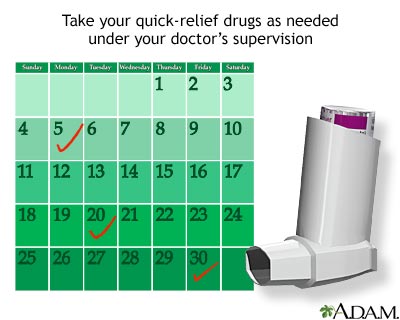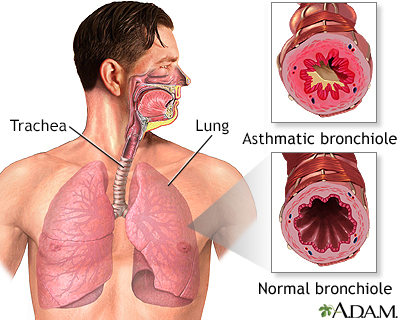Asthma - quick-relief drugs
Asthma - quick-relief drugs - short-acting beta-agonists; Asthma - quick-relief drugs - bronchodilators; Asthma - quick-relief drugs - oral steroids; Asthma - rescue drugs; Bronchial asthma - quick relief; Reactive airway disease - quick relief; Exercise-induced asthma - quick relief

Asthma quick-relief drugs work fast to control asthma symptoms. You take them when you are coughing, wheezing, having trouble breathing, or having an asthma attack.

The major features of the lungs include the bronchi, the bronchioles and the alveoli. The alveoli are the microscopic blood vessel-lined sacks in which oxygen and carbon dioxide gas are exchanged.

Asthma is a disease in which inflammation of the airways causes airflow into and out of the lungs to be restricted. When an asthma attack occurs, mucus production is increased, muscles of the bronchial tree become tight, and the lining of the air passages swells, reducing airflow and producing the characteristic wheezing sound.
Short-acting Beta-agonists
Short-acting beta-agonists are the most common quick-relief medicines for treating asthma attacks and are considered to be bronchodilators.
They can be used just before exercising to help prevent asthma symptoms caused by exercise. They work by relaxing the muscles of your airways, and this lets you breathe better during an attack.
Tell your provider if you are using quick-relief medicines twice a week or more to control your asthma symptoms. Your asthma may not be under control, and your provider may need to change your dose of daily control medicines.
Some quick-relief asthma medicines include:
- Albuterol (ProAir HFA, Proventil HFA, Ventolin HFA)
- Levalbuterol (Xopenex HFA)
- Metaproterenol
- Terbutaline
Short-acting beta-agonists may cause these side effects:
- Anxiety.
- Fast and irregular heartbeats. Call your provider right away if you have this side effect.
- Headache.
- Restlessness.
- Tremor (your hand or another part of your body may shake).
Oral Steroids
Your provider might prescribe oral steroids when you have an asthma attack that is not going away. These are medicines that you take by mouth as pills, capsules, or liquids.
Oral steroids are not quick-relief medicines but are often given for 7 to 14 days when your symptoms flare-up.
Oral steroids include:
- Methylprednisolone
- Prednisone
- Prednisolone
References
Drazen JM, Bel EH. Asthma. In: Goldman L, Cooney KA, eds. Goldman-Cecil Medicine. 27th ed. Philadelphia, PA: Elsevier; 2024:chap 75.
Marcdante KJ, Kliegman RM, Schuh AM. Asthma. In: Marcdante KJ, Kliegman RM, Schuch AM, eds. Nelson Essentials of Pediatrics. 9th ed. Philadelphia, PA: Elsevier; 2023:chap 78.
National Heart, Lung and Blood Institute. Asthma Management Guidelines: Focused Updates 2020.
O'Byrne PM, Satia I. Inhaled ß2 - agonists. In: Burks AW, Holgate ST, O'Hehir RE, et al, eds. Middleton's Allergy: Principles and Practice. 9th ed. Philadelphia, PA: Elsevier; 2020:chap 93.
Pollart SM, DeGeorge KC, Kolb A. Asthma in children. In: Kellerman RD, Rakel DP, Heidelbaugh JJ, Lee EM, eds. Conn's Current Therapy 2024. Philadelphia, PA: Elsevier; 2024:1317-1324.
Vishwanathan RK, Busse WW. Management of asthma in adolescents and adults. In: Burks AW, Holgate ST, O'Hehir RE, et al, eds. Middleton's Allergy: Principles and Practice. 9th ed. Philadelphia, PA: Elsevier; 2020:chap 52.
Version Info
Last reviewed on: 2/3/2024
Reviewed by: Frank D. Brodkey, MD, FCCM, Associate Professor, Section of Pulmonary and Critical Care Medicine, University of Wisconsin School of Medicine and Public Health, Madison, WI. Also reviewed by David C. Dugdale, MD, Medical Director, Brenda Conaway, Editorial Director, and the A.D.A.M. Editorial team.
